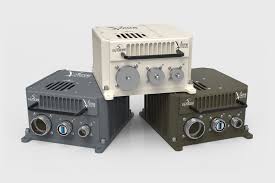
Everything You Need to Know About Automotive Grade Oscillators
- 0
As the engine roars and the wind rushes by, nothing can match the excitement of driving a car. But have you ever pondered what lies beneath the sleek exterior and powerful performance? Behind every automobile is a complex network of electronic systems, all working together to ensure a seamless ride. And at the heart of these cutting-edge vehicles lies one essential component oscillators. In this blog, we’ll delve into the world of automotive grade oscillators – why they are crucial, how to select the right one, and tips for maintaining their optimal function. So fasten your seatbelts and get ready to upgrade your understanding of these unsung heroes that power our beloved cars!
What Is an Oscillator and Why Is It Important in Automotive Systems?
In the realm of electronics, oscillators act as precision conductors orchestrating synchronization within a system. In automotive systems, this is crucial for functions like engine timing, ABS calculations, and entertainment system synchronization. Automotive grade oscillators play a pivotal role, ensuring seamless operation across varying temperatures and environmental conditions.
The precision provided by these oscillators is essential for safety, efficiency, and overall performance. Accurate timing optimizes combustion, enhancing fuel efficiency and reducing emissions. It enables swift reactions of traction control systems, improving stability on slippery surfaces.
Beyond efficiency, precise synchronization facilitates smooth communication between diverse electronic components in a vehicle. From tire pressure sensors to airbag deployment mechanisms, accurate timing ensures harmonious collaboration during critical moments.
To meet stringent industry standards and endure harsh automotive conditions, specialized oscillators, Automotive Grade Oscillators, are employed. These oscillators undergo rigorous testing, ensuring reliability under extreme conditions and maintaining accuracy over time.
Their robust construction minimizes potential failures due to mechanical stress or exposure to contaminants. Moreover, automotive grade oscillators offer enhanced temperature stability, crucial for vehicles operating in diverse climates, from freezing mornings to scorching desert days.
The Importance of Automotive Grade Oscillators
When it comes to automotive systems, precision and reliability are of utmost importance. That’s where automotive grade oscillators come into play. These specialized components are designed specifically for the demanding conditions of automobile applications.
So why are these oscillators so important? Well, they serve as the heartbeat of various electronic systems within a vehicle. From engine control units to infotainment systems, these oscillators ensure that everything runs smoothly and synchronously. Let’s recap the key points.
Heartbeat of Electronic Systems
Automotive grade oscillators serve as the essential timing components for various electronic systems within vehicles, including engine control units and infotainment systems.
Accurate Timing Signals
The precision provided by these oscillators is crucial for coordinating functions such as fuel injection, ABS braking, and other critical operations, ensuring optimal performance and safety on the road.
Harsh Environment Resistance
Automotive grade oscillators must withstand the challenging conditions of automobile environments, including extreme temperatures and vibrations. Their ability to operate reliably in diverse climates is paramount.
EMI/EMC Considerations
Robust shielding measures are necessary to minimize electromagnetic interference (EMI) emissions. Simultaneously, these oscillators must be immune to external interference, ensuring uninterrupted operation in the presence of electromagnetic compatibility (EMC) challenges.
Choosing the Right Oscillator
Manufacturers need to carefully evaluate temperature stability requirements and consider EMI/EMC regulations specific to the automotive industry when selecting oscillators for vehicles.
Understanding Temperature Stability and EMI/EMC Requirements in Automotive Applications
When choosing automotive grade oscillators, understanding temperature stability and meeting electromagnetic interference (EMI) or electromagnetic compatibility (EMC) requirements is crucial. These factors ensure reliable operation in the challenging environments of vehicles.
Temperature stability is vital to withstand extreme temperature fluctuations in automotive settings. Oscillators with good temperature stability maintain frequency output, providing reliable timing for applications like engine control units and infotainment systems.
EMI/EMC requirements focus on preventing unwanted electrical noise that can interfere with sensitive components in vehicles. Automotive grade oscillators meeting stringent EMC standards minimize interference, ensuring smooth operation without disruptions.
To select an appropriate oscillator, consider its specified operating temperature range and maintenance of frequency accuracy within that range. Look for devices designed or tested for automotive use, ensuring compliance with standards like AEC-Q100.
Pay attention to manufacturers’ EMI/EMC specifications detailing measures taken during oscillator design to mitigate potential interference issues. Proper installation and grounding techniques, following PCB layout recommendations, further reduce EMI problems.
Understanding temperature stability and EMI/EMC requirements is vital in selecting a reliable automotive grade oscillator. Considering these factors, along with features like AEC-Q100 compliance, ensures optimal performance throughout a vehicle’s lifespan.
Choosing the Right Oscillator for Your Vehicle
Selecting the right oscillator for your vehicle is crucial for optimal performance and reliability. Consider the following factors.
Compatibility
Ensure the oscillator aligns with your vehicle’s specific system and functionalities, addressing diverse timing requirements.
Frequency Stability
Assess the oscillator’s ability to maintain a consistent frequency over time and under varying conditions, crucial for precision timing in functions like engine control and communication systems.
Temperature Stability
Choose an oscillator that operates reliably across a wide temperature range without significant performance drift, as automotive environments can experience extreme temperature fluctuations.
EMI/EMC Compliance
Confirm the oscillator meets electromagnetic interference (EMI) and electromagnetic compatibility (EMC) standards, preventing interference with other vehicle electronics or external devices.
Power Consumption
Consider the oscillator’s power consumption, as energy-efficient systems contribute to optimized fuel efficiency and extended battery life in vehicles.
Compliance with Industry Standards
Verify if the oscillator complies with industry standards, such as the AEC-Q100 qualification, ensuring reliability in challenging automotive environments.
By carefully addressing these factors, you can confidently choose an automotive grade oscillator that aligns with your vehicle’s unique needs, contributing to overall system reliability and performance.
The Future of Automotive Grade Oscillators
As technology advances, automotive grade oscillators are evolving to meet future demands.
Wireless Integration
Integration of wireless communication capabilities supports connected cars and autonomous vehicles, enabling precise synchronization between onboard systems.
Miniaturization
Oscillators are shrinking in size while maintaining performance, accommodating the trend of compact and space-efficient vehicles.
Power Efficiency
Future oscillators focus on improved power efficiency, crucial for electric and hybrid vehicles, maximizing battery life and overall system performance.
Environmental Sustainability
Anticipated emphasis on eco-friendly solutions, exploring sustainable materials and energy-saving features to reduce the carbon footprint.
5G Adaptation
With the advent of 5G, oscillators must support higher data transfer rates and lower latency for advanced driver assistance systems (ADAS) and autonomous driving.
As vehicles become smarter and more interconnected, automotive grade oscillators will continue to evolve, addressing challenges and aligning with emerging technologies and environmental considerations.
Conclusion
In summary, automotive grade oscillators are essential components that provide accurate timing signals necessary for multiple vehicle functions. When choosing these oscillators, factors like temperature stability and compliance with EMI/EMC standards must be carefully considered.
They have proven to be resilient in harsh environments, thanks to their wide temperature range operation and ability to minimize phase noise, jitter, and frequency fluctuations. As the automotive industry progresses towards autonomy and connectivity, the demand for advanced oscillators will continue to increase, driving higher standards for precision and dependability.
Recognizing their importance contributes significantly to the overall performance of vehicle electronic systems. Moreover, as these components adapt to the ever-changing connected world on wheels and stricter industry regulations, we can expect promising advancements in the future.







